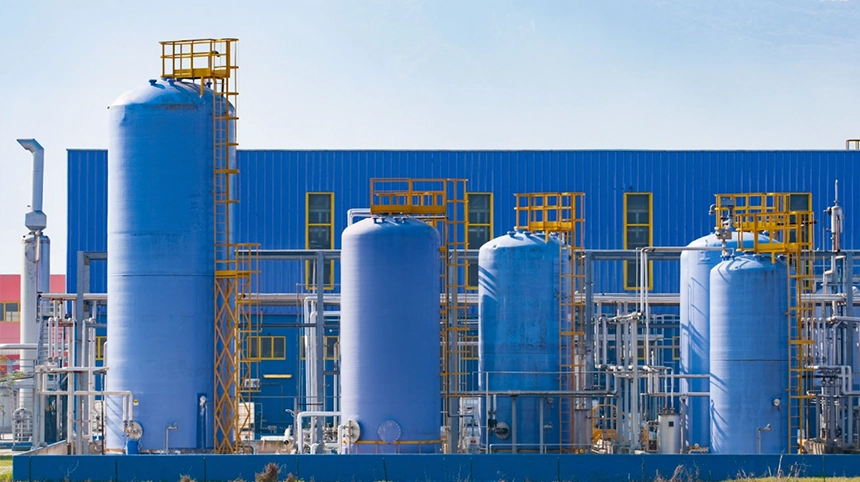DEF Storage Tanks: Design Best Practices for Reliable Urea Storage in Industrial Applications

Introduction
A seemingly simple DEF tank proves vital for the success of selective catalytic reduction (SCR) systems. It directly influences the performance of diesel exhaust fluid (DEF). This pertains to reducing NOx emissions. What is diesel exhaust fluid? It’s a solution of 32.5% urea and 67.5% deionized water, essential for NOx reduction. What is DEF used for? It converts NOx into harmless nitrogen and water in SCR systems. For industrial DEF storage, getting it right is key, and this article offers practical wisdom. It speaks to choosing materials, temperature regulation, and preventing unwanted contamination. After all, poor DEF tank design can lead to messy contamination or worse, full system failures, which could really hurt your compliance. The paper also shows Guantong’s DEF storage system. This system strengthens steady emission control.
Material Selection: The First Hurdle

alt: Large blue industrial storage tanks with yellow access stairs, representing chemical storage facilities.
What is DEF made of? DEF fluid consists of a urea solution, which is highly sensitive to material compatibility. Proper DEF tank materials comprise high-density polyethylene (HDPE) and specific grades of stainless steel (e.g., 316L). These withstand corrosion and preserve DEF quality. Conversely, prohibited materials like carbon steel, copper, or galvanized metals corrode upon contact with urea in DEF. This contaminates the fluid and impairs SCR systems. Is all DEF the same? No, contamination from improper materials can reduce DEF fluid for diesel effectiveness.
Table 1: DEF Tank Material Compatibility
| Material | Compatibility | Notes |
| HDPE | Compatible | Resists corrosion, cost-effective |
| Stainless Steel (316L) | Compatible | Durable for harsh environments |
| Carbon Steel | Incompatible | Corrodes, contaminates DEF |
| Copper | Incompatible | Causes DEF decomposition |
| Galvanized Metals | Incompatible | Releases zinc, poisons catalysts |
- Best Practice: Use HDPE or 316L stainless steel for DEF tanks to ensure longevity.
- Case Study: A cement plant employing HDPE tanks curtailed contamination incidents by 30%. This bolstered SCR system reliability.
The Art of Temperature Management
DEF fluid freezes at -11°C and decomposes above 30°C, affecting DEF quality and SCR system performance. Ideal storage temperatures span 5–25°C. In frigid regions, DEF tanks necessitate heating systems (e.g., electric or immersion heaters) and insulation. This forestalls freezing. Ultimately, it guarantees consistent NOx reduction. Maintenance includes regular checks of heating systems to avoid downtime.
- Recommendation: Install thermostatically controlled heaters for DEF storage systems.
- Example: A power plant in a cold climate reduced downtime by 15% with insulated DEF tanks.
System Design to Prevent Contamination
Contamination from dust, moisture, or debris can compromise DEF quality, leading to SCR system failures. DEF tanks warrant sealing with breather valves. They also necessitate coalescing filters. This impedes external contaminants. Instrumentation and process control instruments monitor tank conditions, ensuring purity. What is a SCR system? It’s a technology that relies on clean DEF fluid for diesel to function effectively. What does SCR mean? Selective catalytic reduction, critical for emissions control.
- Best Practice: Use multi-stage filtration and sealed designs for DEF tanks.
- Case Study: A factory implementing Guantong’s filtered DEF storage system reduced catalyst clogging by 25%.
From “Tank” to “Module”: A Paradigm Shift

alt:An industrial modular process skid with various tanks and piping outside a factory building, illustrating a prefabricated system.
Building DEF tanks, pumps, valves, and pipelines on-site is time-consuming and prone to errors. Guantong’s modular process skid transforms industrial DEF storage. It achieves this with a pre-fabricated, factory-tested DEF storage system. Benefits include:
- Quality Assurance: Pre-assembled process skids ensure consistent performance.
- Integrated Features: This system encompasses heating, coalescing filters and Coriolis flow meters. It also provides liquid level monitoring. This occurs via instrumentation and control.
- Efficiency: For those considering metering skids, here’s a definite plus: expect to see installation time drop by as much as 50%. What’s more, potential risks are also lessened by 20%.
Case Study: A petrochemical plant deployed Guantong’s modular process skid. This attained NOx emissions below 50mg/Nm³. It also yielded a 30% reduction in setup time.
Conclusion
Dependable industrial DEF storage commences with proper DEF tank design. However, modular solutions refine this process. Achieving NOx reduction with SCR technology hinges on using superior DEF fluid. Good news: AdBlue DEF, just like standard DEF, requires the same careful storage. Guantong’s DEF storage system thoughtfully brings together metering, calibration, and fine-tuned process control tools. This simply ensures you meet all regulations. Why not look into Guantong’s adaptable DEF system? It brings professional engineering and spot-on emission results.
